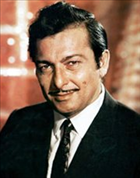


In the forties Anil Biswas was a big name among the film music directors. Much to his chagrin, in all his recording sessions one young boy would just barge in to cheekily suggest, "I think that tune needs some change." Once the veteran composer lost his cool and blasted, "If you want to change the tunes, first learn to make them yourself and then do whatever you like!" Little did Anilda know then that destiny had already penned a musical script for the future of that young boy named Madanmohan Kohli - for music lovers simply 'Madanmohan'!
Born on 25th June 1924 in Baghdad, Madanmohan grew up in an atmosphere steeped in films. Raibahadur Chunilal- his father was the chief of famous 'Filmistan' studio. Yet thanks to a strange twist of fate, Madanmohan started off as a soldier with a British Army commission during Second World war. Needless to say this job was not to last long and the magic of music - his first love- soon pulled him away from the mayhem of gun-shots.
Although as a composer he was to scale hitherto unscaled heights, it was as a singer he entered the film music world. Lata Mangeshkar recalls how a twenty-something Madanmohan had met her as a co-singer at a 'Shaheed' song recording. Lata- who herself was a young struggler then- had initially thought him to be just another pretender making it thanks to his paternal connections! She was pleasantly surprised when he sang the song well and complimented him when he just said, "Oh, that was okay. My ambition is to become a composer."
Composer he did become soon. 'Aankhein' (1950)- his first soundtrack immediately proved his mettle with fine songs like ‘Preet laga ke maine’ (Mukesh) and ‘Mori atariya pe kaaga bole’ (Meena Kapoor). 'Ada'(1951)- the next venture then confirmed his entry into the hall of fame with a trio of Lata beauties ‘Ankhon ankhon mein unse pyar ho gaya’, ‘Sanwari surat man bhayee re piya’ and ‘Preetm meri duniya mein’. For the next 25 years his music was to set new standards in class and creativity. Commercially it might not have been too successful but qualitatively it certainly represented the best that ever was.
Barring some of his forgettable soundtracks in his early career when he was forced to ape the inimitable O.P. Nayyar’s style for survival, Madanmohan's music always showed great emotional depth and originality. Mellow, melodious, mature and moving - this music was something special - to be savoured slowly in the serene settings of solitude during those soul-searching, soft moments. Although this quality endeared him to the classy connoisseurs, it also alienated him from the masses who preferred easy listening. His son poignantly remembers the hurt look on his father's face when he would invariably find his children humming someone else's popular tunes. It must have constantly reminded him of his own inability to demystify his music to common listeners.
It was not as if he couldn't compose in the lighter vein. Fabulous numbers like ‘Ai dil mujhe bata de’ (Geeta Dutt), ‘Jhumka gira re’ (Asha Bhosle) and ‘Zaroorat hai’ (Kishore Kumar) amply demonstrated his flair for fast, frothy, foot-tapping numbers. But it was his mastery in creating emotional, soulful classics which really defined his genius. Who else could have conceived such touchingly expressive songs like ‘Beraham aasman’ (Talat), ‘Kabhie na kabhie’ (Rafi), ‘Bhooli hui yaadon’ ( Mukesh) and ‘Sabah se yeh kah do’ (Asha)!
When it came to ghazals, Madanmohan was the king of all. His compositions in that genre were at a different plane altogether. If one singer more than anyone else made that possible, it was Lata. Theirs was a real dream team - a fact acknowledged even by greats like Naushad and O.P. Nayyar. ‘Hum pyar mein jalnewalon ko’ ( Jailor), ‘Yun hasraton ke daag’ ( Adalat), ‘Lag jaa gale’ ( Woh kaun thi), ‘Aap ki nazarone samjha’ ( Anpadh), ‘Khelo na mere dil se’ ( Haqeeqat)- so many gems were created through this magical, musical association.
Madan's usage of Indian classical music was charmingly innovative. ‘Kaun aaya mere man ke dware’ ( Raag Raageshree), ‘Jiya le gayo ji mora sawariya’ ( Raag Yaman- Kalyan), ‘Meri veena tum bin roye’ ( Raag Ahir-Bhairav), ‘Bairan neend na aaye’ ( Raag Kaafi) and ‘Haale dil yun’ ( Raag Pahadi) are few examples of how beautifully he used the full range of raagas in film music. So particular was he about sur that when a musician repeatedly missed his notes during the recording of that great Bhimpalasi raag- based song from 'Mera saaya'- ‘Naino mein badara chhaaye’, Madan angrily broke the glass-door of the recording room! The only thing he kept on saying then was - "How dare you be disloyal to the sur in my music?"
This loyalty to sur helped him in the long run to outlast most of his contemporaries. He was one of the few composers from the Golden Era of fifties who managed to hold their own even after the advent of seventies. ' Dastak', 'Hanste zakhm', ' Hindustan ki kasam', ' Dil ki raahein' and ' Mausam' soundtracks bore enough testimony to his ability to mould his music according to changing trends. Even his latter year songs like 'Maai ri' (Lata), 'Tum jo mil gaye ho' (Rafi), 'Har taraf ab yehi afsane hain' (Manna Dey), ‘Simti si sharmaayee si’ (Kishore) and 'Dil dhoondhata hai' ( Bhupendra) repeatedly confirmed his capability of composing classics even in the cramped, commercial cine-music settings.
Over the years his orchestration might have become progressively westernised but his tunes always retained their Indian-ness in tact and that made them stand-outs. It was to his credit that despite his commercial failures he never succumbed to the lure of cheap Westernism unlike many of his contemporaries. On 14th July 1975 he left this world leaving behind a great musical legacy.
They don't make music like him any more! In fact, they don't make men like him any more!